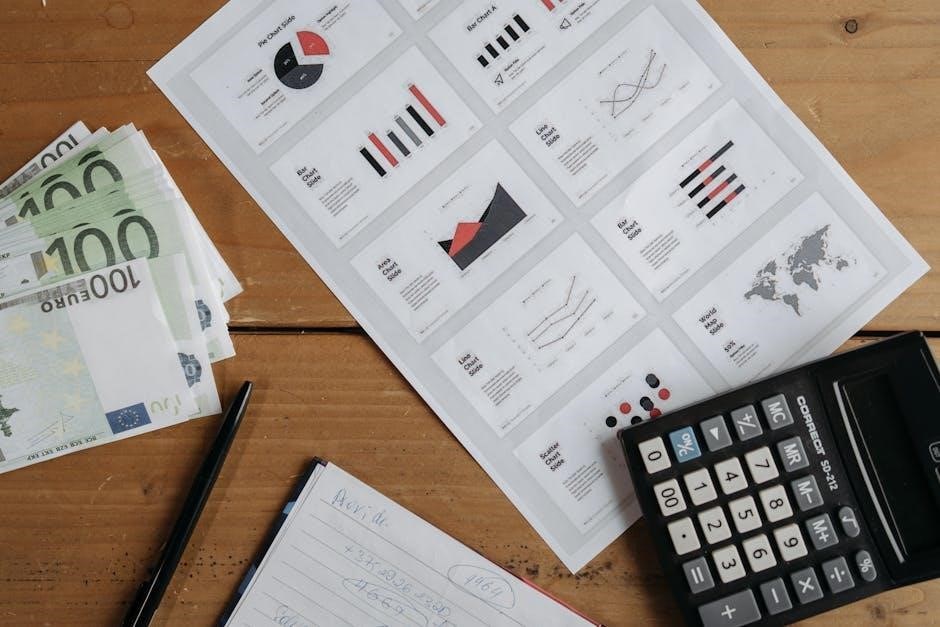Mixed numbers combine whole numbers and fractions‚ while improper fractions have numerators larger than denominators. Understanding both is essential for mastering fraction operations and conversions.
1.1 Definition of Mixed Numbers
A mixed number is a combination of a whole number and a proper fraction. For example‚ in the mixed number 1 1/2‚ the whole number is 1‚ and the fractional part is 1/2. Mixed numbers are used to represent quantities that include both whole amounts and partial amounts‚ making them easier to understand in real-world contexts like recipes or measurements.
1.2 Definition of Improper Fractions
An improper fraction is a fraction where the numerator is greater than or equal to the denominator; For example‚ in the fraction 10/7‚ the numerator (10) is larger than the denominator (7). This type of fraction represents a quantity greater than one whole and is often converted to a mixed number for easier interpretation in real-world applications. Improper fractions are essential in mathematical operations and are frequently used in advanced fraction problems and calculations.
1.3 Importance of Converting Between Mixed Numbers and Improper Fractions
Converting between mixed numbers and improper fractions is crucial for simplifying mathematical operations. Mixed numbers are easier to interpret in real-world contexts‚ while improper fractions are more convenient for calculations. Mastering this conversion enhances problem-solving skills and is essential for advanced math concepts. Worksheets and practice exercises‚ such as those in PDF format‚ provide structured learning opportunities‚ helping students grasp this fundamental skill through examples and exercises tailored to different grade levels.

Step-by-Step Guide to Converting Mixed Numbers to Improper Fractions
Convert mixed numbers to improper fractions by multiplying the whole number by the denominator‚ adding the numerator‚ and placing the result over the original denominator.
2.1 Understanding the Conversion Process
Understanding the conversion process between mixed numbers and improper fractions is fundamental. A mixed number combines a whole number with a proper fraction‚ while an improper fraction has a numerator greater than its denominator. To convert‚ multiply the whole number by the denominator‚ add the numerator‚ and place it over the original denominator. For example‚ 1 3/7 becomes (1×7 + 3)/7 = 10/7. This process ensures accurate calculations in various mathematical operations‚ making it a crucial skill for students to master. Regular practice using worksheets helps reinforce this concept‚ preparing students for more complex fraction problems in higher grades.
2.2 Multiplication of the Whole Number by the Denominator
Multiplying the whole number by the denominator is a key step in converting mixed numbers to improper fractions. For example‚ in the mixed number 1 3/7‚ multiply the whole number (1) by the denominator (7) to get 7. This step establishes the foundation for combining the whole number and the fractional part into a single improper fraction. Using worksheets‚ students can practice this multiplication skill‚ ensuring accuracy before proceeding to the next step of adding the numerator. This method reinforces the concept of how improper fractions represent the same value as mixed numbers but in a different form.
2.3 Adding the Numerator to the Product
After multiplying the whole number by the denominator‚ the next step is to add the original numerator to this product. This sum becomes the new numerator of the improper fraction. For instance‚ in the mixed number 1 3/7‚ after multiplying 1 (whole number) by 7 (denominator) to get 7‚ add the numerator 3 to this product‚ resulting in 10. The denominator remains the same‚ creating the improper fraction 10/7. This step is crucial as it combines the whole number and the fractional part into a single value‚ simplifying further calculations. Using PDF worksheets‚ students can practice this addition step‚ ensuring they grasp how to merge the components accurately. This process is fundamental for converting mixed numbers to improper fractions effectively and can be reinforced through repetitive practice exercises.
2.4 Simplifying the Resulting Fraction
After adding the numerator to the product‚ the resulting fraction may not be in its simplest form. To simplify‚ identify the greatest common divisor (GCD) of the numerator and denominator and divide both by this number. For example‚ if the improper fraction is 10/7‚ it is already in simplest form. However‚ if the fraction is 12/8‚ the GCD is 4‚ so dividing both by 4 results in 3/2. Simplifying ensures the fraction is easy to work with and understand. Practice worksheets can help students master this step‚ reinforcing the concept through repetition and varied examples.
Practice Worksheets for Converting Mixed Numbers to Improper Fractions
Practice worksheets offer structured exercises to master conversions‚ with 20 problems per sheet. They cater to various grades‚ ensuring comprehensive understanding and fluency in fraction operations‚ available in PDF formats.
3.1 Grade 4 Fractions Worksheets
Grade 4 worksheets focus on foundational skills‚ introducing students to converting mixed numbers to improper fractions. They include step-by-step examples‚ visual aids like fraction bars‚ and interactive activities. These resources help young learners understand the relationship between whole numbers and fractions‚ fostering a strong base for advanced fraction operations. Coloring exercises and real-world applications‚ such as measurement and recipes‚ make learning engaging. Available in PDF format‚ these worksheets are easily accessible and customizable to meet individual learning needs‚ ensuring a smooth transition to higher-level math concepts.
3.2 Grade 5 Fractions Worksheets
Grade 5 worksheets on converting mixed numbers to improper fractions are designed to reinforce foundational skills while introducing more complex problems. These resources include step-by-step examples‚ visual aids like fraction bars‚ and interactive activities to enhance understanding. Students practice converting mixed numbers to improper fractions through problem sets‚ ensuring mastery of the concept. Worksheets also incorporate real-world applications‚ such as measurement and recipes‚ to make learning practical and engaging. Available in PDF format‚ these tools are easily accessible and customizable to suit various learning styles and pacing needs.
3.3 Interactive Activities and Coloring Exercises
Interactive activities and coloring exercises make learning fun and engaging for students. These tools often include visual aids like fraction bars‚ which help students visualize the conversion process. Coloring exercises allow students to identify and highlight different parts of mixed numbers and improper fractions‚ reinforcing their understanding. Many worksheets incorporate these activities alongside problem sets‚ encouraging hands-on learning. Additionally‚ interactive PDF versions offer features like drag-and-drop or matching games‚ enhancing the educational experience. These resources are designed to be both educational and enjoyable‚ catering to different learning styles and preferences.

Differentiation Strategies for Teaching the Concept
Differentiation strategies include using visual aids like fraction bars and coloring exercises to cater to diverse learning needs and preferences‚ enhancing engagement and understanding.
4.1 Developing Questions for Various Skill Levels
Teachers can create tiered questions to cater to different skill levels. For beginners‚ focus on basic conversions using simple fractions. For advanced students‚ incorporate complex mixed numbers and word problems. Include visual aids like fraction bars to aid comprehension‚ especially for visual learners. Additionally‚ provide opportunities for peer discussion and hands-on activities to reinforce learning. This approach ensures all students‚ from struggling to gifted‚ are challenged appropriately and supported effectively in mastering the concept of converting mixed numbers to improper fractions.
4.2 Using Visual Aids like Fraction Bars
Visual aids‚ such as fraction bars‚ are highly effective for teaching the conversion between mixed numbers and improper fractions. Fraction bars provide a concrete representation of wholes and parts‚ making abstract concepts more tangible. For example‚ coloring specific sections of a bar can help students visualize how a mixed number combines a whole and a fraction. This tool is particularly beneficial for visual and tactile learners‚ as it allows them to physically break down and rebuild numbers. By using fraction bars‚ educators can simplify complex concepts and reduce confusion‚ fostering a deeper understanding of fraction operations.

Real-World Applications of Improper Fractions
Improper fractions are essential in real-world tasks like cooking and construction‚ where precise measurements are critical. Understanding conversions aids in scaling recipes and materials accurately.
5.1 Practical Examples in Measurement and Recipes
Improper fractions are invaluable in real-world scenarios like cooking and construction. For instance‚ recipes often require scaling‚ where converting mixed numbers to improper fractions simplifies calculations. Imagine doubling a recipe that calls for 1 3/4 cups of flour; converting it to 7/4 cups ensures accuracy. Similarly‚ in construction‚ materials like lumber may be measured in mixed numbers‚ and converting them to improper fractions aids in precise cuts and layouts. These practical applications highlight the everyday utility of mastering fraction conversions.

Benefits of Using PDF Worksheets for Practice
PDF worksheets offer accessibility‚ convenience‚ and customization‚ making them ideal for practicing fraction conversions. They provide clear examples and exercises‚ suitable for various grade levels and learning styles.
6.1 Accessibility and Convenience
PDF worksheets for converting mixed numbers to improper fractions are highly accessible and convenient. They can be easily downloaded‚ printed‚ or shared digitally‚ making them ideal for classroom or home use. Students can practice anytime‚ anywhere‚ without requiring internet access. PDFs maintain consistent formatting across devices‚ ensuring clarity and readability. This convenience allows learners to focus on understanding and mastering fraction conversions without technical distractions. Additionally‚ PDFs are widely compatible‚ making them a practical choice for educators and students alike. Their portability and ease of use enhance the learning experience‚ promoting effective practice and skill development.
6.2 Customization Options for Different Grades
PDF worksheets for converting mixed numbers to improper fractions can be customized to suit various grade levels‚ ensuring tailored practice for different learning needs. For younger students‚ worksheets may include visual aids like fraction bars or simplified examples‚ while older students can tackle more complex problems. Educators can adjust difficulty by varying numerator and denominator sizes or introducing mixed operations. This flexibility allows teachers to create differentiated instruction‚ catering to diverse skill levels and learning paces. Customization enhances engagement and ensures that all students can practice effectively‚ building a strong foundation in fraction conversion skills. This adaptability makes PDF worksheets a valuable resource for educators seeking to meet individual student needs. By offering a range of challenges‚ these worksheets promote progressive learning and mastery of the concept.
